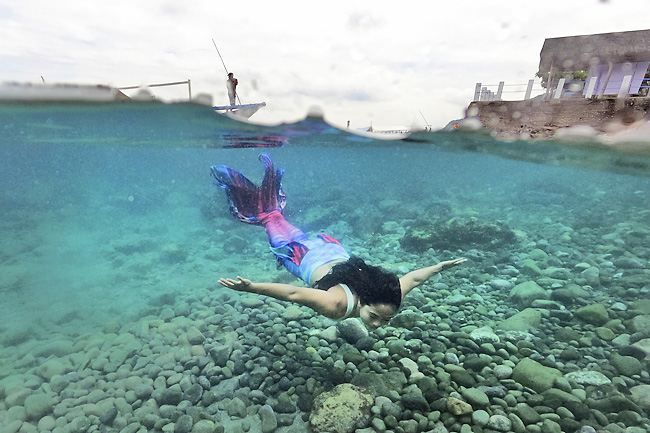SYDNEY (AP) – There was a pivotal moment in Queen Pangke Tabora’s life that eclipsed all others: It was the moment, she said, when she first slid her legs into a mermaid tail.
For the middle-age Filipina woman, seeing her legs encased in vibrant, scaly-looking neoprene three years ago was the realisation of a childhood dream. And it marked the beginning of her immersion into a watery world where she would find acceptance. The former insurance company worker described the experience of gliding under water, half-human and half-fish, as “meditation in motion”.
“The feeling was mermai-sing,” Tabora said one recent morning while lounging in a fiery red tail on a rocky beach south of Manila, where she now teaches mermaiding and free-diving full-time. “The world outside is really noisy and you will find peace under water. It’s a good skill in the real world, especially during the pandemic.”
Across the world, there are thousands more merfolk like her – at its simplest, humans of all shapes, genders and backgrounds who enjoy dressing up as mermaids. In recent years, a growing number have gleefully flocked to mermaid conventions and competitions, formed local groups called “pods”, and poured their savings into a multimillion-dollar mermaid tail industry.
On a planet plagued by war, disease and social upheaval, many merfolk have found life in the water a refuge. Perhaps Sebastian, the ornery crab in the 1989 film The Little Mermaid, said it best in his warning to land-loving mermaid Ariel: “The human world, it’s a mess. Life under the sea is better than anything they got up there!”


Away from the critics and chaos of life on land, mer-world is the kinder, gentler and more joyful alternative to the real world. It is also a world, merfolk say, where you can be whoever and whatever you want.
That openness attracts some minorities who empathise with Ariel’s agony of being trapped in a body that feels wrong. It is also inspiring to merfolk like Che Monique, the Washington, DC-based founder of the Society of Fat Mermaids, which promotes body-positive mermaiding.
“I’m a 300-pound Black mermaid in America over 35, and hopefully that tells somebody they can do whatever they want to do,” said Monique.
“Sure, on the one hand it is really silly, but I’ve watched it change people’s lives.”
The lure of mermaiding is clear from the Montreal home of Marielle Henault, which is stuffed to the gills with mermaid tails. The AquaMermaid CEO sells them to “mers” the world over.
“When you put your mermaid tail on at the beach or pool, you become a superstar,” said Henault.
When mermaiding first started to catch on, most tails for sale were custom-made silicone creations that weigh up to 23 kilogrammes, cost upwards of USD6,000 and take a surprising amount of time and lubricant to wrestle into. But over the past few years, the increasing availability of cheaper, lighter fabric options opened up mermaiding to the wider public.
As mermaiding went mainstream, glamorous photos of mermaids resplendent in glitzy tails began gaining traction on social media, further fuelling mer-mania. An obsession with The Little Mermaid is common among merfolk, and there is anticipation of a fresh wave of mermaiding interest when a live action reboot of the film is released next year.
Still, merfolk acknowledge their almost-utopia is occasionally rocked by stormy seas. As mermaiding’s popularity has risen, so too has the prevalence of creeps known as “merverts” and scammers who sell non-existent tails, said creator of the Facebook group ‘Mermaids Beware: Scammers, Merverts, & More’ Kelly Hygema.
“Being mermaids, it’s a predominantly women-dominated hobby and profession… so of course that does attract attention from strangers on the Internet,” said Hygema.
“Most of the time it’s just creepy comments, like they want to see you without the tail on or hold your breath underwater.”
Hygema advises merfolk to always have a trusted companion, or “mertender”, while performing in a tail.






